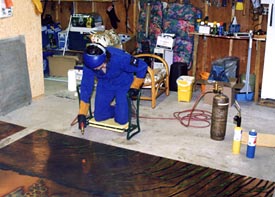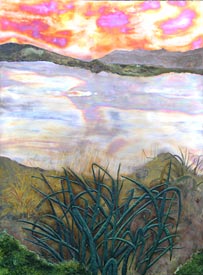Chemistry on Copper: The Works of Cheryl Safren
 Copper artist Cheryl Safren at work
Copper artist Cheryl Safren at workPhotograph courtesy of Cheryl Safren
It might be hard to imagine that a one-car garage could be the space so many unique and compelling copper works come out of, but for Cheryl Safren of New York, it's all part of the big picture. Safren was a fine art painter since 1975, creating flyers, brochures and packaging and teaching art classes on the side. But in 2001, while helping her son create various chemical reactions on copper for a school project, she was sent on a different trajectory.
"I didn't know what the reactions would be. We kept scientific data, including length of submersion, and documented it daily." They used vinegar, lemon juice, hydrogen peroxide and salt solutions, she recalls. "It was so primitive," Safren says, certainly compared to her current work. Her son quickly lost interest, "But I could not stop," she says. "I've always loved the color of copper because my mother had naturally copper-colored hair. It's such a beautiful color."
Safren became hooked on the diverse and richly colored chemical reactions with copper. She contacted a cousin who was a chemical engineer, "for safety reasons," she admitted, "because some of the things I use are not good for you." Without a studio she took her experiments outside.
"My earliest efforts of applying chemistry on metal were in my back yard on a bed of sand," she says. "I was using temperatures of 3,000 degrees. Wood burns and concrete explodes, so working inside my house was not a good idea."
 Sand Cove, chemistry and plastic on copper
Sand Cove, chemistry and plastic on copperPhotograph courtesy of Cheryl Safren
Eventually she converted the garage into a studio where things like wind, snow and rain were appeased. Though she won't divulge the specific types and combinations of chemicals she uses, due to her years of experimenting, she will apply heat to her copper sheet on occasion with the chemicals to produce certain effects.
"I use many chemicals and heat," says Safren. "Some chemicals are applied cold, then heated, some never receive heat. Chemical reactions vary, some are instantaneous, some take weeks and years. The natural oxidations process also changes depending on the humidity."
She purchases copper sheet from B & B Sheet Metals in Long Island City. From there she begins to apply different chemical reactions on her test strips---small copper foil she uses as guinea pigs. "For every work I create I use many test strips," says Safren. "I had 82 test strips for a triptych I recently did." And each test is numbered, defining its chemical makeup so she doesn't have to re-invent the wheel. Older test strips are brought to Two Brothers Scrap Metal in Farmingdale, New York and sold. "My public works are sealed with Incralac so there is no chromatic degradation or oxidation," she says. Then there are her "living paintings," copper works which are not sealed and where the environment plays a part in the evolution of the piece. "I do things to promote changes and encourage texture and growth so things come out in many colors and layers," she says. "You don't know exactly how they will evolve."
She stresses that she does not etch copper, the chemicals reside on top of the sheet creating diversity of color and texture.
"When you look at my work it changes depending on the light, the time of day, the angle from where you're standing," says Safren. "The dynamic interaction is compelling."
Currently she's experimenting with crystal formations which fan out like ferns across the copper sheet to create dynamic images with an almost prehistoric feel. "There are thousands of crystal formations which form in a myriad number of formations," she says. Her work at times seems other-worldly, funky odd shapes and colors that seem to resemble amoebas under glass, or science fiction book covers.
Much of her work is not purchased within the arts community.
"I'm not a chemist, though the main buyers of my work are science people. I'm called an applied chemist, but this isn't my education," she says with a laugh.
Commissions include Florida State University, Psychology Building in Tallahassee, FL, the City of Aurora, Colorado, and the University of Montana, Skaggs Science Building in Missoula, among others. Running October 26th through December 2, will be "The Alchemy of Art" at Adelphi University in New York. Her two foot by three foot copper works sell between $2,000 to $3,000, while her three foot by four foot pieces fetch $3,000 to $5,000. She would love to work on larger copper canvases, but, after all, it's still a one-car garage.
Resources:
Also in this Issue:
- Contemporary Furniture Designers Turn to Copper
- Chemistry on Copper: The Works of Cheryl Safren
- Pomegranate Metals: A Family Legacy
- Uncovering the History of Coppertown USA
- Calder's Brass Jewelry on View
